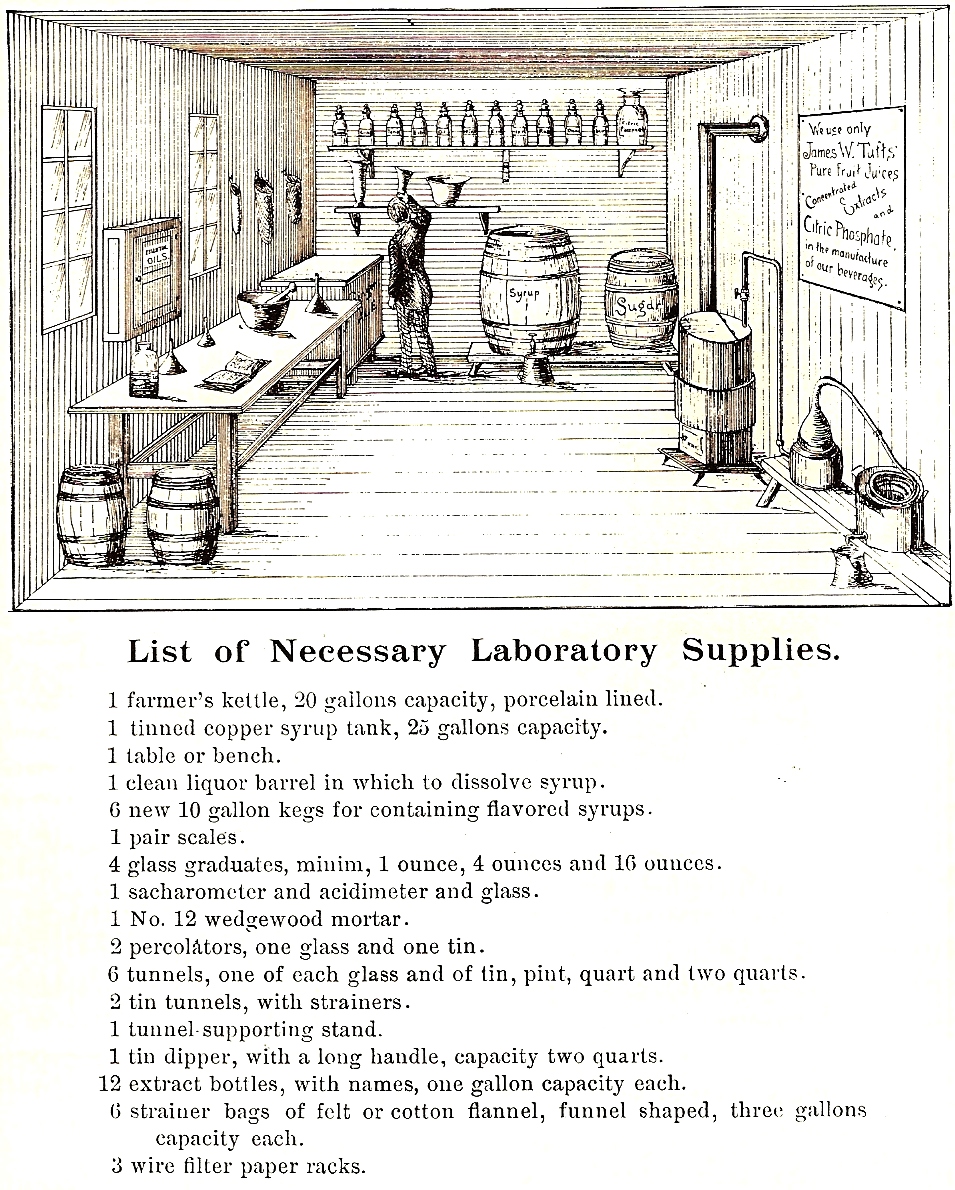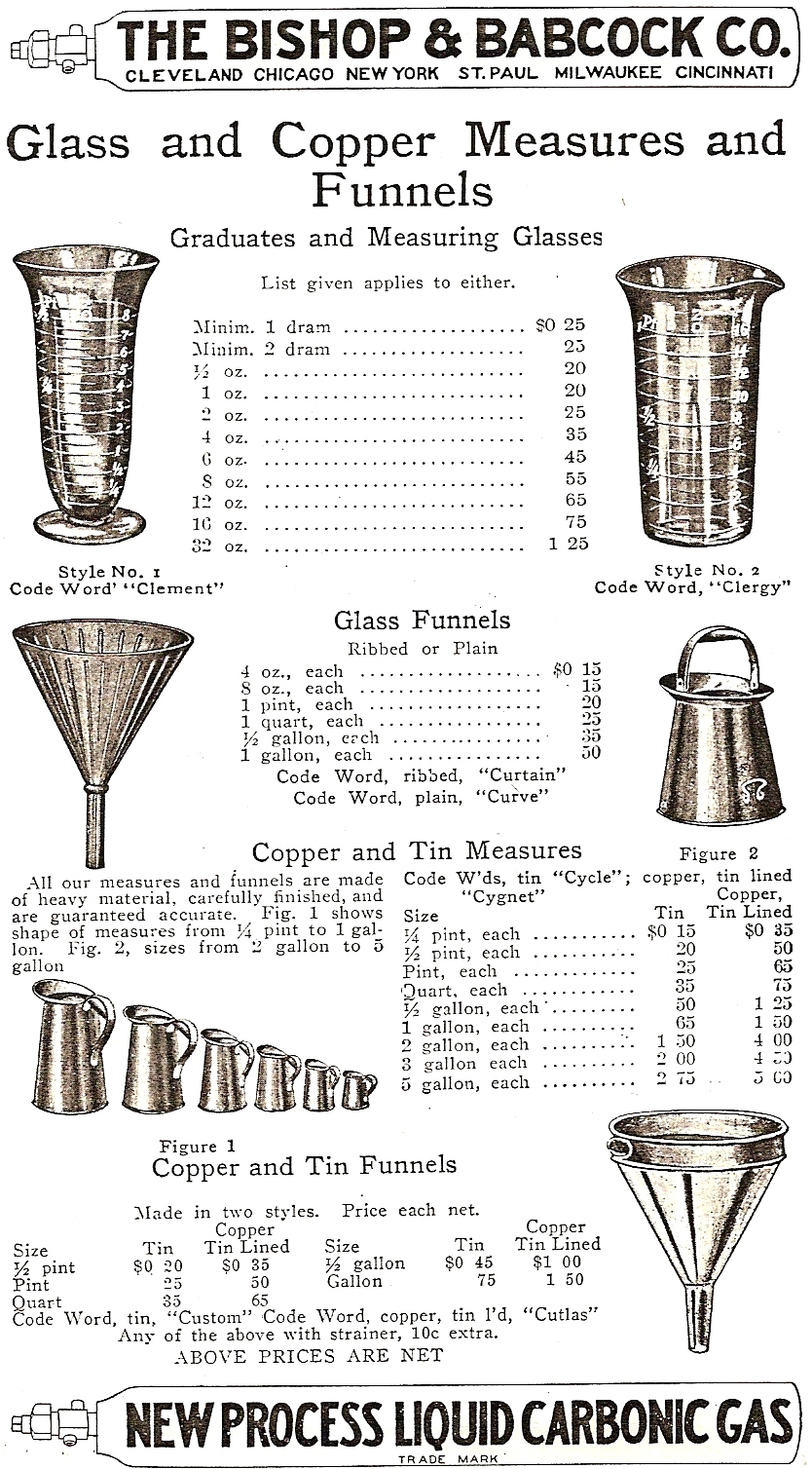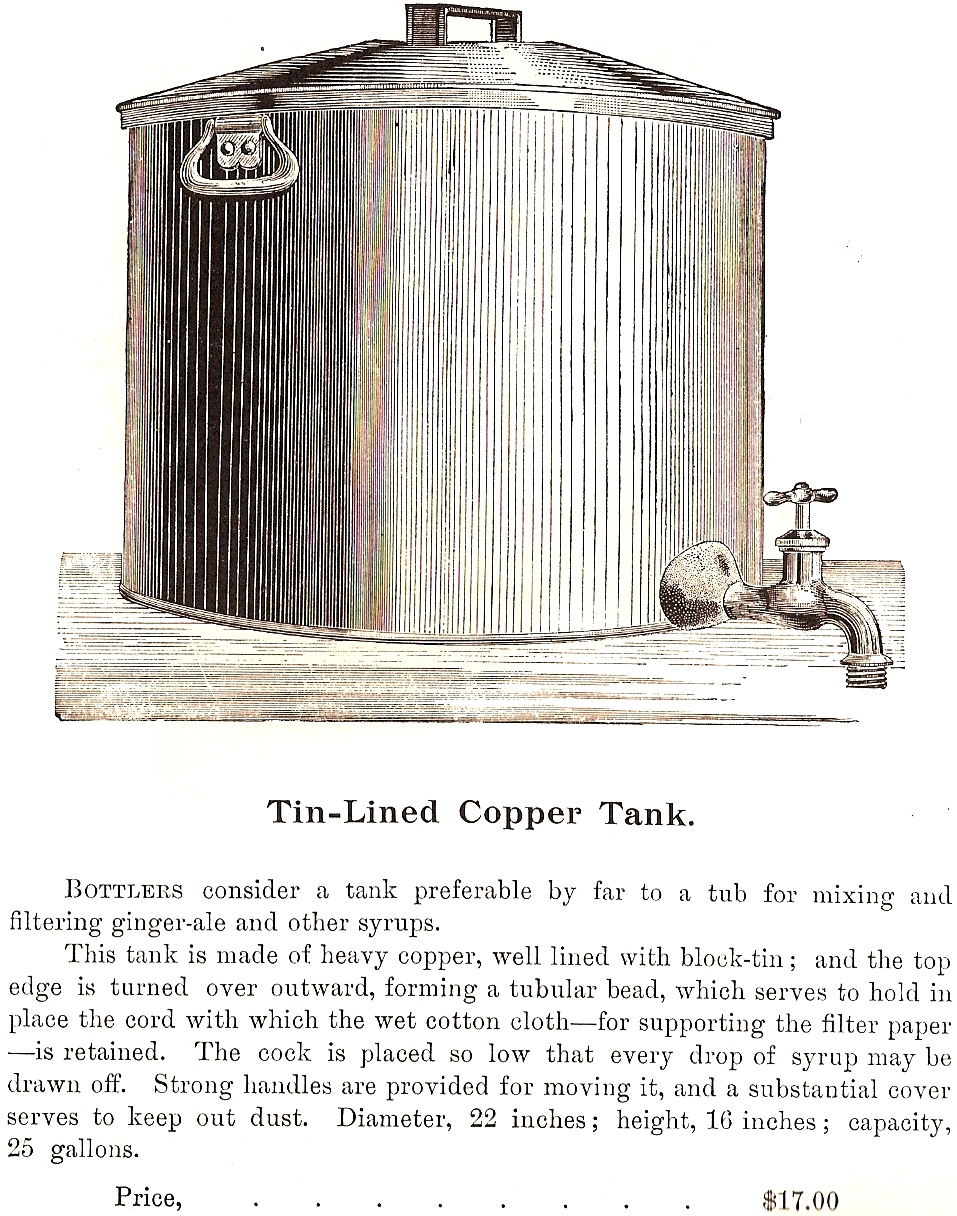Syrups
Simple syrup was made by
dissolving granulated sugar in filtered water in order to produce a
basic, thick sugar solution.
Syrups were produced by either hot or cold processes.
Hot process syrup was made by dissolving sugar at a
ratio of 50 pounds of granulated sugar to 4.5 gallons of warm, filtered
water. The mixture was
heated very slowly and never boiled.
Perfectly clean, twenty to forty gallon, tin-lined copper tanks
were used to mix and contain the syrup.
A spigot at the base of the tank was used to draw off the
contents after mixing and the syrup’s strength was measured with a
hydrometer. The syrup was
strained or filtered thru felt, flannel, or silk before it cooled, and
again before use. Most
bottlers made their own syrups, but purchased their extracts.
Fresh fruits were often mashed and mixed with the syrup for
flavoring, but this type of syrup was highly perishable and could only
be used on the day it was made.
Cold process syrup was made by dissolving granulated
sugar in cold, filtered water by stirring the mixture.
Cold process syrup wasn’t as desirable as hot process syrup
because undissolved sugar often crystallized and clogged the syrup gauge
valves.
James W. Tufts provided strong guidance on “The
Manufacture of Syrups” in his 1888 book,
The Manufacture and
Bottling of Carbonated Beverages,
including:
The most important point to be observed in the
manufacture of syrups is scrupulous cleanliness.
This point cannot be too strongly insisted on, as upon it depends
the ultimate success of many manipulations.
Even the smallest bottling establishment should have a
place set apart as a laboratory.
Both the quality and cost of various beverages depends upon the
care and accuracy with which the various ingredients are compounded.
In order to have a uniform and even quality of goods,
it is necessary to have proper measures, filters, tubs, etc.
If a spoon is used for a graduate, an old sieve for a filter, and
the household wash-tubs and boiler instead of tanks and kettles
specially provided, the goods cannot fail to be of poor quality…The cost
of the necessary articles is not great, and with care they will last for
years…
The laboratory should be supplied with a jacket-kettle
or similar contrivance for making simple syrup.
It is not safe to use dry heat in preparing syrup, as it is
easily burned…
The hydrometer, a closed glass tube, graduated and
weighted at the end, for determining the density of liquids, is a
necessary instrument in the laboratory.
The various hydrometers used by the bottler, are the
alcoholometer, for liquid lighter than water, and the sacharometer and
acidimeter for liquids heavier than water…
A graduate glass for fluid measures should also be
supplied. These articles
enable the bottler to dispense with the use of scales for weighing,
which require so much care to keep clean, besides saving time and labor
in handling.
Filtering paper, large-mouthed bottles for salts and
extracts, and earthen jars for holding syrups, are also necessary
adjuncts of the laboratory…
A wooden spoon or stick should be used in stirring
syrup which contains acid…
To make Syrup Brilliant…(and) produce a perfectly
transparent beverage for use of bottlers and others, it is simply
necessary to…Mix one ounce of powdered carbonate of Magnesia with each
gallon of flavored syrup, and filter through fine flannel.
A little of the first run should be filtered a second time until
it runs clear. The improved
appearance of the beverage makes the process a most desirable one…
No inflexible rule can be given for the use of color.
Always color to suit, and use care not to get too high a color.
Acid and color should not be added to syrup one immediately after
the other. Add the
flavoring or foaming extract between the two.
Use good extracts.
There is nothing in which more deception can be practiced.
Always purchase extracts
from thoroughly reliable
houses.
Here are two examples of Tufts’ typical syrup
formulas:
Strawberry
Syrup.
Simple Syrup = 1 gallon
Tufts’ Strawberry Extract = 1 ounce
Fruit Acid = 1 ounce
Soda-Foam = 2 ounces
Fruit Color = 2 ounces
Cream Soda.
Simple Syrup = 1 gallon
Tufts’ Cream Soda Extract = 2 ounces
Tartaric Acid = 1 ounce
Soda-Foam = 1 ounce
Tufts also provided mixing and storage advice for
Soda-Foam, Fruit Acid, and Tartaric Acid, helping to better understand
the usage of these frequently added ingredients:
Soda-Foam.
Tufts’ Dry Soda-Foam (one package) = 4
ounces
Alcohol = 4 ounces
Water = sufficient
Place the Dry Soda-Foam in a pint bottle and fill with
water; place the bottle in hot water for several hours; when cold,
strain through cloth and allow to settle until it becomes clear.
Decant; add the alcohol and enough water to make it measure 1 ½
pints. This will never
spoil. Be careful not to
use enough to taste. Never
add foam to syrup until about to use it.
Fruit Acid.
Citric Acid = 4 ounces
Boiling Water = 8 ounces
Dissolve thoroughly and strain through a flannel
cloth. Keep this acid
solution in a glass or stone bottle or jug, well corked.
Prepare in small quantities, as it will become musty if kept too
long.
Tartaric Acid
Solution.
Tartaric Acid = 3 ounces
Hot Water = 8 ounces
Dissolve the acid in the hot water and filter through
paper. Never keep much of
this solution in stock, as dissolved tartaric acid is a very unstable
article, and apt to deteriorate on short notice.
The following illustration and list of suggested lab
supplies accompanied Tufts’ discourse on syrups:

The following page of measures
and funnels offered for sale in Bishop & Babcock’s 1909
Bottler’s Machinery –
Bottler’s Supplies catalog illustrates the typical variety
of laboratory supplies utilized by many bottlers:

Here’s an advertisement for a
syrup tank (also referred to as a “syrup can”) that James W. Tufts was
selling in 1888:

Charles
Sulz included the identical syrup can illustration in his 1888 book
A Treatise on Beverages or
The Complete Practical Bottler and cautioned:
Syrup Receptacles…are the necessary conjunctions of
the bottling machine with syruping arrangement.
They contain the ready-made and previously flavored syrup which
feeds the syrup gauge or syrup pump, and is intended for flavoring
carbonated water. It is
necessary or at least advisable, where different beverages by a
continuous bottling process are being produced, to have for each kind of
flavored syrup a separate syrup can or tank, which can be quickly and
without delay connected with the syrup gauge and bottling machine…
It is highly important to avoid any exposure of
flavored syrups to copper, lead or zinc, as its chemical action on such
metals results in a contamination which not only destroys its beneficial
effects, but renders it positively noxious.
Ordinary tin vessels should be banished from the bottling
establishment. Galvanized
iron tanks are unfit for syrup receptacles, as the syrup would be
contaminated by the zinc, which is the coating of such tanks.
To secure perfect purity it is necessary to use syrup tanks lined
with good block or sheet tin, thus making any contact of the syrup with
injurious metal absolutely impossible.
Porcelain-lined syrup tanks or slate tanks or glass
vessels are the best, as even tin will be gradually attacked by the
syrup and the citric and tartaric acids it contains…No metal faucets
should be attached to syrup receptacles; faucets of glass or porcelain
are the best.
Glazed earthenware vessels should not be used, since
it is known that into their finish chemical compounds, lead, etc.,
enter, which injuriously affect the syrups and even destroy their
flavors.
Tufts also supplied this combined sacharometer and
acidimeter:

Flavorings were added to the syrup before use.
The 1910 W. H.
Hutchinson and Son Bottlers’ Supplies
catalog recommended:
When flavoring syrup, put in one ingredient at a time
and mix thoroughly before adding another, using a wooden spatula or
stick to stir. Never use
metal. Use only the best
flavors and coloring, and beware of cheap dealers and fraudulent goods.
Do not confound quality with strength.
The essential qualities of bottlers’ flavors are delicate
fruitiness of flavor, rich aroma and solubility.
Too great concentration impairs these qualities and injures the
bright, clear, sparkling appearance of the beverages…Coloring should be
used very carefully. Avoid
high colors.
The 1889
W. H. Hutchinson & Son Manufacturers and Dealers in Bottlers Supplies
catalog offered the following advice to bottlers concerning syrups,
flavors, and general cleanliness:
TAKE NOTICE.
1.
Never flavor Syrups when hot.
2.
Stir each ingredient as soon as put into the Syrup,
before adding another, and stir well.
3.
Follow directions explicitly, and then if you
require a stronger flavor, or anything different, add to suit yourselves
and the locality you are in.
4.
You
cannot mix your Syrups and flavors too much; the longer you
stir them the better; and be sure you
strain them well.
5.
Have the tubs and everything used in making Syrups
very clean. It would be well
to keep lime water on hand, and every two weeks at least, wash
thoroughly all the utensils used in connection with the Syrups.
This will prevent them from getting musty, and kill all animal
matter that may have accumulated…
6.
We would advise all
bottlers to use a weak solution of sal. Soda and water in washing their
bottles…After washing the bottles in this water, rinse with fresh water,
and your bottles will be bright and clean as a new silver dollar.
 HutchBook.com
HutchBook.com